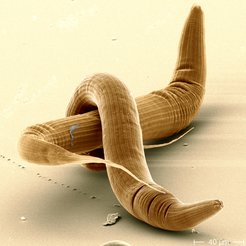Mating without males decreases lifespan
Roundworm species reproducing self-fertilization instead of mating with males have shorter lifespans
Pristionchus nematodes come in two varieties: Most species consist of typical males and females, but in several species the females have evolved the ability to produce and use their own sperm for reproduction. Scientists from the Max Planck Institute of Developmental Biology in Tübingen, Germany, discovered that these so called hermaphrodites have shorter lifespans, with females frequently living over twice as long as closely related hermaphrodites.

The ways that males and females interact affects many biological processes, including the evolution of important traits like lifespan and the rate of ageing. While the male-female mating system is found in most vertebrates, and all mammals—many animal species employ alternative arrangements. Ralf Sommer and Cameron Weadick from the Max Planck Institute of Developmental Biology are doing research on the evolutionary consequences of such differences. They wanted to find out if self-fertilizing hermaphrodite nematodes would evolve to live longer, healthier lives; or if they would evolve shorter life cycles, characterized by quick bursts of reproduction followed by senescent decay. By comparing species that utilize different mating systems, it’s possible to see how much of a role sexual interactions play in shaping life-history evolution.
The researchers measured adult lifespan in females and hermaphrodites from eleven different Pristionchus nematode (roundworm) species. They discovered that hermaphrodites, which fertilize their own eggs with their own sperm, live significantly shorter than their female relatives. Importantly, lifespan did not correlate with the number of offspring, indicating that the lifespan differences between females and hermaphrodites aren’t simply due to a trade-off between living long and investing in reproduction.
There are various possible reasons for the differences in lifespan. Hermaphrodites start reproducing earlier in life, as they produce sperm before adulthood, but females have to invest time to find males to mate with. Another reason relates to the costs of mating: Males can damage females during mating, and the females may need to be built especially strong in order to tolerate this, leading to the evolution of females capable of living for a long time. Finally, decreased lifespan in hermaphrodites may be a consequence of inbreeding, which can impede natural selection and lead to the accumulation of damaging mutations. These mechanisms are not mutually exclusive, and a key challenge for future work will be to determine the relative contributions of each process.
"We want to investigate the connection between survival and the mating system. Our results set the stage for future work on the genetic basis of differences in lifespan”, says Weadick. Apart from Pristionchus nematodes, the relation between self-fertilization and lifespan has only been investigated in plants so far. The comparison with other species might help to identifying genes that are associated with the evolution of lifespan.
